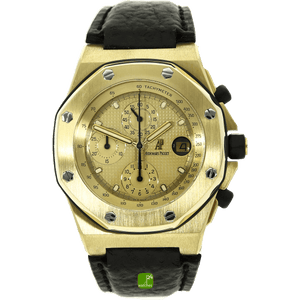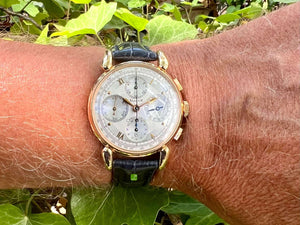Die Evolution des Chronographen: Vom Zeitmesser zur technischen Meisterleistung
Frühe Anfänge: Bereits im 18. Jahrhundert experimentierte der französische Uhrmacher Louis Moinet mit einem eigenständigen Sekundenzeiger. Dieses Gerät konnte Zeitintervalle in Bruchteilen einer Sekunde messen und war für astronomische Beobachtungen gedacht.
Das 19. Jahrhundert - das goldene Zeitalter des Chronographen
1821 - wurde der Begriff "Chronograph" von dem Uhrmacher Nicolas Mathieu Rieussec ins Leben gerufen. Er entwickelte einen Chronographen für Pferderennen.
19. Jahrhundert - wurden Chronographen für wissenschaftliche und industrielle Anwendungen genutzt. Sie fanden Anwendung in den Bereichen Astronomie, Navigation, Medizin und später auch in der Luftfahrt und im Motorsport.
1960er Jahre: kam es zu einem bedeutenden technologischen Fortschritt in der Entwicklung von automatischen Chronographenwerke. 1969 stellten mehrere Firmen gleichzeitig den ersten automatischen Chronographen vor, darunter Zenith mit dem legendären El Primero und ein Konsortium von Heuer, Breitling, Büren und Hamilton mit dem Kaliber 11.
Moderne Anwendung
20. / 21. Jahrhundert - sind Chronographen nicht nur Werkzeuge zur Messung von Zeitintervallen, sondern auch begehrte Sammlerstücke. Symbole für Präzision und Handwerkskunst.
Hier die Schritt für Schritt Anleitung wie Sie einen Chronographen nutzen
 Den Chronographen starten
Den Chronographen starten
Drücken Sie den Start-/Stopp-Drücker bei der 2-Uhr Position
Dies setzt den zentralen Sekundenzeiger in Bewegung und startet die Zeitmessung
 Den Chronographen stoppen
Den Chronographen stoppen
Drücken Sie erneut den Start-/Stopp-Drücker bei der 2-Uhr-Position
Dies stoppt den zentralen Sekundenzeiger und die Zeitmessung endet. Der zentrale Sekundenanzeiger bleibt auf der aktuellen Zeit stehen.
 Die abgelaufene Zeit ablesen
Die abgelaufene Zeit ablesen
Zentraler Sekundenanzeiger: Zeigt die verstrichenen Sekunden an.
Hilfszifferblätter: Zeigen die verstrichenen Minuten / Stunden an - je nach Modell und Chronograph.
 Den Chronographen zurücksetzen
Den Chronographen zurücksetzen
Drücken Sie den Reset-Drücker bei der 4-Uhr Position
Dieser Drücker setzt den zentralen Sekundenzeiger und die Zeiger in den Hilfszifferblättern auf Null zurück.
Jetzt ist der Chronograph bereit für eine neue Messung!
FAQs zu Chronographen
Was ist ein Chronograph?
Chronograph kommt aus dem griechischen und bedeutet "Zeitmesser". Sie verfügen über zusätzliche Funktionen um Zeitintervalle zu messen.
Für wen ist ein Chronograph?
Ein Chronograph ist ein äußerst vielseitiges Instrument, das sowohl professionell als auch für persönliche Anwendungen nützlich sein kann. Die Auswahl des richtigen Chronographen hängt von den spezifischen Anforderungen und Vorlieben des Trägers ab.
Was bedeuten die Anzeigen auf einem Chronographen?
Die häufigsten Anzeigen auf einem Chronographen - Hilfszifferblätter- sind:
- Minutenzähler
- Stundenzähler
- Tachymeter - eine Skala auf dem Außenrand des Zifferblattes oder der Lünette, die zur Berechnung der Geschwindigkeit einer Strecke verwendet wird.
- Telemeter: diese Skala befindet sich am äußeren Rand des Zifferblattes. Es wird verwendet, um die Entfernung eines Ereignisses zu messen - wie beispielsweise ein Gewitter.
- Pulsometer: diese Skala befindet sich am äußeren Rand des Zifferblattes und misst die Herzfrequenz basierend auf der Zeit.
Einige Chronographen haben nur eine dieser Skalen, aber auch immer abhängig von dem Uhren-Design.
Viele Chronographen kombinieren zwei oder mehr dieser Skalen auf dem Zifferblatt. Die Skalen sind dann oft in konzentrischen Kreisen oder verschiednen Ringen angeordnet, um Platz zu sparen und die Lesbarkeit zu gewährleisten.
Und was ist ein Chronometer?
Ein Chronometer ist ein Uhrwerk, das nach extrem hohen Präszisionsstandards zertifiziert wurde. Im Gegensatz zu einem normalen Chronographen, der eine Stoppuhrfunktion bietet, liegt der Schwerpunkt bei einem Chronometer auf außergewöhnliche Genauigkeit. Diese Prüfung wird durchgeführt und zertifiziert von der COSC (Contrôle Officiel Suisse des Chronomètres).
Anwendungsbereiche für einen Chronometer sind beispielsweise für die Marine und im Bereich der Forschung.
Warum sind gebrauchte Chronographen oft teurer als neue Modelle?
Einige gebrauchte Chronographen sind teurer, weil sie selten, limitiert oder historisch bedeutend sind. Sammler suchen oft nach spezifischen Modellen, die nicht mehr produziert werden, was deren Wert steigern kann.
Was sollte man beim Kauf eines gebrauchten Chronographen beachten?
Beim Kauf eines gebrauchten Chronographen sollten Sie auf den Zustand der Uhr, ihre Authentizität, die Wartungshistorie und die Vertrauenswürdigkeit des Verkäufers achten. Dokumentation und Originalteile können ebenfalls den Wert und die Zuverlässigkeit beeinflussen.
Welche Marken bieten die besten gebrauchten Chronographen?
Gebrauchte Chronographen und ihr Marktwert
Der Wert eines gebrauchten Chronographen kann von verschiedenen Faktoren beeinflusst werden. Hier sind einige der wichtigsten Schlüssel-Faktoren:
Marke und Modell
Einige Marken und Modelle haben aufgrund ihrer Geschichte oder Exklusivität einen höheren Wert. Beispielsweise haben Rolex und Patek Philippe oft einen hohen Wiederverkaufswert.
Seltenheit
Limitierte Auflagen oder seltene Vintage-Modelle sind oft wertvoller, da sie für Sammler begehrenswert sind.
Zustand
Der Zustand der Uhr, des Gehäuses, Zifferblatts und der Mechanik spielt eine große Rolle. Originalteile und eine gut gepflegtes Werk erhöhen den Wert.
Wartungshistorie
Eine Uhr mit einer dokumentierten Wartungshistorie ist oft mehr wert, da sie beweist, dass die Uhr gut gepflegt wurde.
Zertifikate und Dokumente
Originaldokumente, Zertifikate und die Originalverpackung können den Wert eines gebrauchten Chronographen erheblich steigern.
Warum gebrauchte Chronographen eine wertvolle Anschaffung sind
Gebrauchte Chronographen bieten eine einzigartige Möglichkeit, ein Stück Geschichte zu besitzen und gleichzeitig von den funktionalen Vorteilen eines komplexen Zeitmessers zu profitieren. Sie sind nicht nur eine kostengünstige Alternative zu neuen Modellen, sondern bieten auch das Potenzial für Wertsteigerungen und den Zugang zu seltenen und begehrten Modellen.
Egal, ob Sie ein erfahrener Sammler sind oder gerade erst in die Welt der hochwertigen Uhren einsteigen, gebrauchte Chronographen bieten eine Fülle von Möglichkeiten, Ihren Stil und Ihre Präferenzen auszudrücken.
Ich bin für Sie da!
Ottostr. 5 - Nähe Stachus
80333 München
IHR ANSPRECHPARTNER ANDREAS HILDEBRAND
📞 +49 89 123 64 70
post@watches24.com - Emails werden in maximal 24 Std. beantwortet - tagsüber meistens schon innerhalb kurzer Zeit.
Öffnungszeiten Laden
Mo - Fr, 12:00 bis 18:00
Sa, nach Vereinbarung
Sonn- und Feiertage geschlossen
Telefonische Erreichbarkeit
von 09:00 bis 21:00 Uhr

Welches Feedback bekommen wir?
Kurz gesagt: fair, freundlich, kompetent und professionell


Diese Uhrentypen können dich auch interessieren:
Fliegeruhren | Taucheruhr | Damenuhren
In diesen Städten kaufen wir auch Uhren an:
Uhr verkaufen Berlin | Uhr verkaufen Dresden | Uhr verkaufen Leipzig
 100% Echtheitsprüfung |
100% Echtheitsprüfung |
 vor Ort seit 2008 |
vor Ort seit 2008 |
 Trusted Shop |
Trusted Shop |
 Experten-Rat +49 89 123 64 70
Experten-Rat +49 89 123 64 70




















 Den Chronographen starten
Den Chronographen starten Den Chronographen stoppen
Den Chronographen stoppen Die abgelaufene Zeit ablesen
Die abgelaufene Zeit ablesen Den Chronographen zurücksetzen
Den Chronographen zurücksetzen